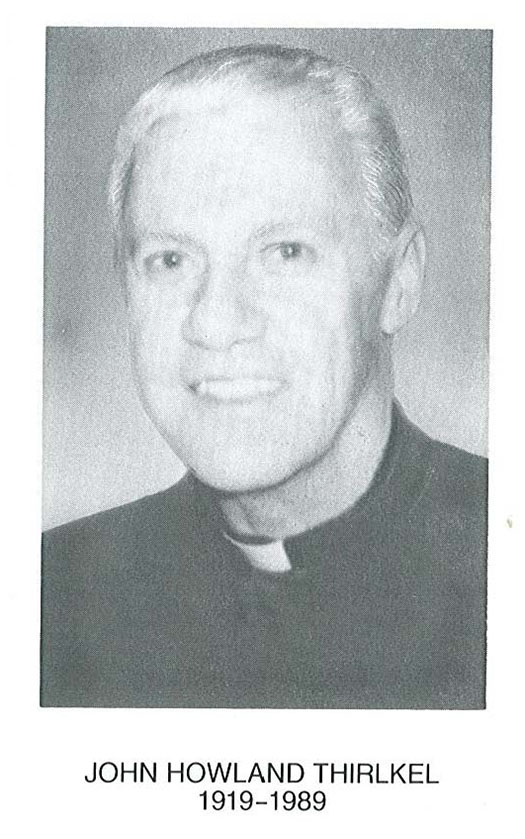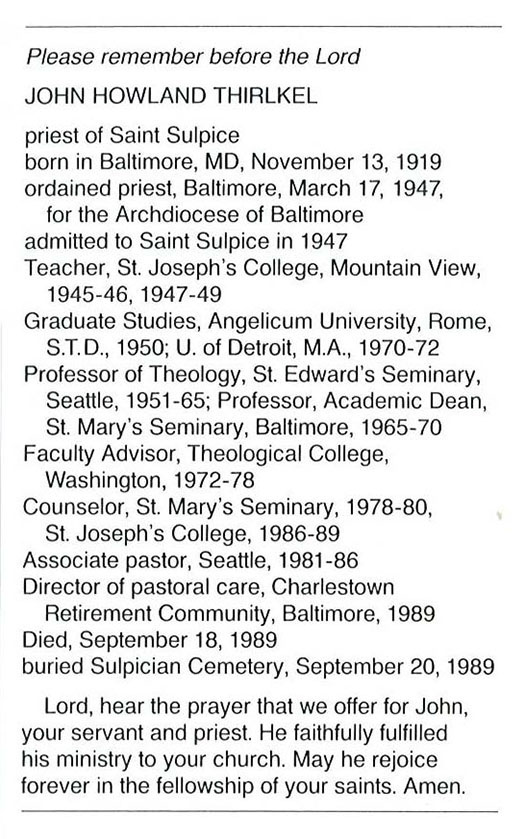Thirlkel, Father John Howland
1989, September 18
Date of Birth: 1919, November 13
September 23, 1994
On Sunday afternoon, September 17, 1989, there was a reception in the Fireside Dining Room at Charlestown for all the new members of the Pastoral Ministry Department of the seven-year-old retirement community. Chief among those honored was Father John H. Thirlkel, S.S., who had arrived earlier in the month to become Charlestown’s Catholic chaplain. He was coming to fill the void created by the retirement the previous June of Father Charles P. Dillon, S.S., on the occasion of his golden jubilee as a priest. The reception was a warm welcome to Father Thirlkel that confirmed the special place he had won in the hearts of the Charlestown residents in a few short weeks. That evening John Thirlkel went home to St. Charles’ Villa, had a massive heart attack, and died at St. Agnes’ Hospital the next afternoon, September 18. Word reached Charlestown during the daily Mass in the Chapel of Our Lady of the Angels; Passionist Father Basil Stockmeyer, who’d been acting chaplain all summer, was visibly shaken as he shared the sad news with the people present.· We were left to ponder what had been and what might have been.
John Howland Thirlkel was born November 13, 1919, the son of William Edmund and Mary Regina Finn Thirlkel. (His mother died in 1937, and his father in 1960.) His early schooling was at St. Paul’s School in Baltimore and then later at St. Bernard’s School. In 1933 he followed the lead of his older brother W. Edmund Thirlkel by entering St. Charles College. Both of them were excellent students, both became Sulpician candidates, and both made their major seminary course at St. Mary’s, Paca Street and Roland Park. In 1943, Edmund left the seminary of his own choice, served in the armed forces in World War II, and later taught philosophy at Mount St. Mary’s College, Emmitsburg, and elsewhere; he survived his younger brother. John in the meantime had served as editor of the Borromean at St. Charles College, had been master of ceremonies at Paca Street, had served on the Voice staff in his years at Roland Park. In all stages of his seminary career he showed interest and skill in dramatics, even appearing in 1939 in Emmet Lavery’s “First Legion” along with fellow Sulpician candidates, Paul Genovese and William Hill. Finally, at the end of the first year of wartime acceleration, he was ordained priest by Archbishop Michael J. Curley on March 17, 1945, at the old Baltimore Cathedral. He returned to St. Bernard’s the next day for his first solemn Mass, assisted by Monsignor Edwin Leonard, the pastor who had sent him to the seminary.
Four weeks later, he went back to offer the community Mass at St. Charles College on April 14, and then he began teaching 2nd Greek for the rest of that school year. That summer he was assigned to St. Joseph’s College, Mountain View, California, where he served until the following year; then he returned to St. Mary’s, Paca Street, for his year of Solitude. Father Lyman A. Fenn, S.S., assisted by Father John S. McDonough, S.S., led the eight candidates in their year of special formation. John Thirlkel had for his confreres Aloysius Bernhard, Robert Callahan, Jack Canfield, Robert Giguere, Thomas Leigh, Eugene Van Antwerp, and Porter J. White. The Superior and his Socius gave John Thirlkel a stirring recommendation in May 1947:
Father Thirlkel is one of God’s noblemen. He is a very simple, child-like, docile character, yet by no means a weakling, for he has a mind and opinions of his own and a sturdy independence which enables him to take care of himself very well. He entered whole heartedly into the spirit of the Solitude and profited much from the year. His humility is his greatest charm though he has much which he could be proud of. His mind is clear, personal, and rather deep; and his meditations were the best given in Solitude. He has the social qualities of a good community man; he is genial, has a good sense of humor, an even disposition, and the ability to give and take with the best but with no meanness ...
In his year at St. Joseph’s he had become very interested in minor seminary work, but in Solitude his interest returned to what he had wanted earlier, the teaching of Dogma. And so, though he was asked to return to St. Joseph’s for another two years, he was able in the fall of 1949 to begin graduate theological studies at the Pontifical Atheneum Angelicum in Rome.
When he returned to the United States at the end of 1950, the new Doctor of Theology was assigned to St. Edward’s Seminary, Kenmore, WA, then both a major and minor seminary. There he taught Dogma, Eucharist, and Ascetics to the majors and Latin to the minors. He soon became moderator of the Harvester and director of a whole series of dramatic productions; including “Oklahoma.” When St. Thomas Major Seminary on the same grounds was dedicated in 1958, Father Thirlkel moved there and, from 1963 to 1965, served as master of ceremonies.
In 1965 John Thirlkel was called back to Baltimore to undertake the responsibilities of Dean and Registrar at St. Mary’s, Roland Park, as well as to teach 3rd Year Dogma and Penance and to direct the dramatic efforts of that community, especially a marvelous production of “Camelot.” In his five years at Roland Park he served under a series of rectors, Fathers John Sullivan (his rector previously in Seattle), John Dede, Jack Canfield, and Jack Greenalch. In 1968 he was described rather laconically (in a footnote) as “Director of the Evening School.” This was the result of preliminary involvement with the Lutheran Seminary in Gettysburg, Pennsylvania, and the United Church of Christ Seminary in Lancaster, Pennsylvania; it was the beginning of the Ecumenical Institute, now flourishing these more than twenty years. In effect, he was the first Dean of that great ecumenical effort. But it was also a time of great turmoil after Vatican II and in the turbulent late ‘60s. In the aftereffects of the issuing of Pope Paul’s Humanae vitae, when a number of the seminary faculty publicly opposed the decree, John Thirlkel felt bound to uphold his confreres and as a result had to give up the Dean’s job. As Father Gerald Brown noted in his funeral homily:
Community which he loved and needed was in crisis. He experienced loneliness and a need to make a change in his life. At the same time, he struggled with a problem which he came to face head on, alcoholism. Out of his suffering, John emerged a man with a new career who knew his limits, who could glory in his weakness. A vulnerable man, he allowed God’s love to enter in more deeply and to bring healing of mind, spirit, and body, and he opened himself more profoundly to the love of family, brother Sulpicians, and friends.
After some months at Guest House he moved to Presentation parish in Detroit, Michigan, entered the University of Detroit, and obtained an M.A. in clinical psychology in 1972.
For the next six years John worked at the Theological College in Washington, D.C. He helped set up the Pastoral Program there, was a counselor and faculty advisor, and served as coordinator of the Liturgy Program. In 1975 he became head of the Provincial Spiritual Renewal Committee. That fit in with the work he had long been involved in: the giving of retreats to priests in such places as Vancouver and Victoria, B.C., and in Davenport, Iowa, and to the Sisters of Divine Providence in Melbourne, KY, in 1966. He had also given a paper at the Sulpician retreat in the summer of 1963 on “The Aims and Content of Spiritual Direction in the Major Seminary.” His work in Washington ended in 1978 when he moved to St. Mary’s Seminary College in Catonsville and provided psychological and counseling services at Roland Park.
In 1980 he had enough trouble with emphysema that he spent a year at St. Charles Villa. While recuperating, he won $1,000 in a TV game contest. Then he went back to Seattle to serve as an associate at St. Anthony’s parish in Renton, WA, and a year later began filling a similar position at St. Jude’s parish, Redmond, WA. This latter assignment allowed him to live with some fellow Sulpicians at St. Thomas Center, the former-seminary now closed. In January·1987 he transferred to St. Joseph’s College, where he served on the formation staff for two years and a half.
Then, some months before the 1989 earthquake that destroyed the Mountain View site of St. Joseph’s, John Thirlkel was invited to come back to Baltimore to succeed Father Dillon as chaplain at the Charlestown Retirement Community. He regarded the transfer as a chance to drive back by way of Seattle and along the northern route across the United States and to visit relatives and friends en route. We learned only later that he had had some sort of difficulties with his lungs in the spring of 1989 and that he had had coronary problems on the way home that necessitated a hospital stay in Sioux Falls, S.D. But he persevered with the trip, arrived in Baltimore around Labor Day, and took up residence at St. Charles Villa. Before the round of introductions at Charlestown had been completed, John Thirlkel had received his final summons.
Fittingly, Father Thirlkel’s body was laid out on Tuesday afternoon in the Chapel of Our Lady of the Angels at Charlestown, where he had begun his priestly studies and where his priestly labors came to an end. That evening, his confreres and other friends joined in a Vespers service, with the homily by Father Maurice O’Neil, S.S., a close associate in his time in California. Next morning, retired Archbishop William D. Borders of Baltimore was the principal celebrant of the Mass of Christian Burial with forty priests joining him; present too were his brother Edmund, his sisters Regina Ash and Ruth Bateman, and many other relatives and friends. He was laid to rest in the Sulpician Cemetery, off the east end of the campus. In the words of Paul to the Romans, quoted by Father Gerald L. Brown, the Sulpician Provincial, in his homily: “May John have complete victory in Christ who loves us.”


